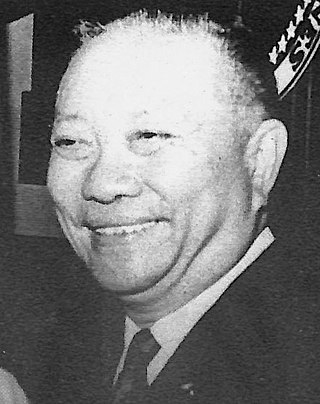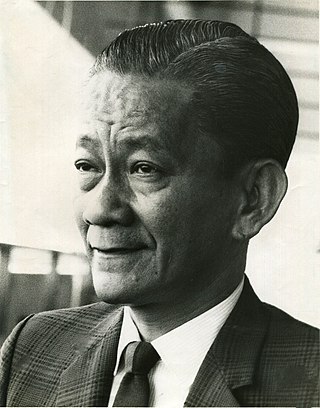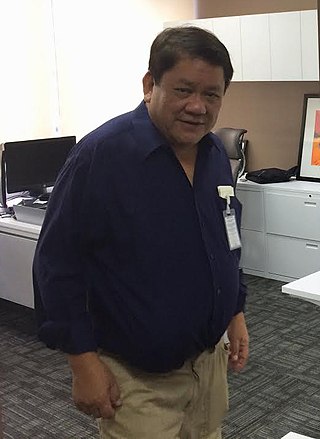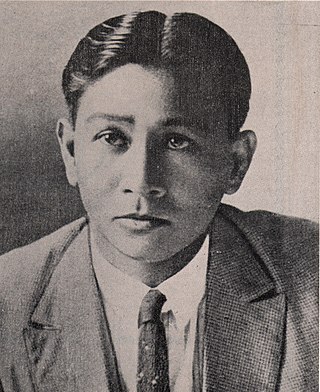Related Research Articles

Sergio Osmeña Sr. was a Filipino lawyer and politician who served as the fourth President of the Philippines from 1944 to 1946. He was Vice President under Manuel L. Quezon. Upon Quezon's sudden death in 1944, Osmeña succeeded him at age 65, becoming the oldest person to assume the Philippine presidency until Rodrigo Duterte took office in 2016 at age 71. A founder of the Nacionalista Party, Osmeña was also the first Visayan to become president.

Fernando Hofileña Lopez Sr. was a Filipino statesman. A member of the influential Lopez family of Iloilo, he served as vice president of the Philippines for under Presidents Elpidio Quirino from 1949 to 1953 under the Liberal Party and Ferdinand Marcos from 1965 to 1972, under the Nacionalista Party. He was also the chairman of ABS-CBN Corporation from 1986 to his death in 1993.

Sergio "Serging" Veloso Osmeña Jr. was a Filipino politician who served as a Senator of the Philippines, and ran against Ferdinand Marcos in the 1969 Philippine Presidential election. He was the son of Sergio Osmeña, the fourth president of the Philippines. His son, Sergio "Serge" Osmeña III, was also a Senator of the Philippines.
General elections were held in the Philippines on November 11, 1941. Incumbent President Manuel Luis Quezon won an unprecedented second partial term as President of the Philippines via a landslide. His running mate, Vice President Sergio Osmeña also won via landslide. The elected officials however, did not serve their terms from 1942 to 1945 due to World War II. In 1943, a Japanese-sponsored Republic was established and appointed José P. Laurel as president. From 1943 to 1945, the Philippines had two presidents. Quezon died in 1944 due to tuberculosis and was replaced by Sergio Osmeña.

Sergio "Serge" de la Rama Osmeña III is a Filipino politician and legislator who served as a Senator of the Philippines. He is a grandson of the 4th president of the Philippines, Sergio Osmeña. In his eighteen years in the Senate, Osmeña chaired the most committees and filed the most bills in the history of the institution.

Tomas dela Rama Osmeña, known as Tommy Osmeña, is a Filipino politician who served as the Mayor of Cebu City thrice: first from 1987 to 1995, again from 2001 to 2010, and lastly from 2016 to 2019. He also served as Congressman representing the second district of Cebu City from 2010 to 2013. He is a grandson of former Philippine President Sergio Osmeña.

The First Congress of the Commonwealth of the Philippines, also known as the Postwar Congress, and the Liberation Congress, refers to the meeting of the bicameral legislature composed of the Senate and House of Representatives, from 1945 to 1946. The meeting only convened after the reestablishment of the Commonwealth of the Philippines in 1945 when President Sergio Osmeña called it to hold five special sessions. Osmeña had replaced Manuel L. Quezon as president after the former died in exile in the United States in 1944.

Elections for the Senate of the Philippines were held on November 11, 1947, with eight of the 24 seats in the Senate being contested. These eight seats were elected regularly; the winners were eligible to serve six-year terms from December 30, 1947, until December 30, 1953. Gubernatorial and local elections were held on the same date.

Molo is a district in Iloilo City, in Iloilo Province, on Panay Island in the Western Visayas region of the Philippines. It is the most densely populated district of all the seven districts of Iloilo City. It was originally a separate municipality before it became part of Iloilo through Act No. 719 of 1903. Molo's historical significance stems from its role as the Parián or Chinatown of Iloilo, where the Chinese residents of the city resided.

The Nacionalista Party is the oldest political party in both the Philippines and in Southeast Asia in general. It is responsible for leading the country throughout most of the 20th century since its founding in 1907; it was the ruling party from 1935 to 1946, 1953–1961 and 1965–1972.
The Araneta family is a Filipino family that originated from Guipúzcoa, the Basque region of northern Spain. The name is derived from the Basque word aran meaning "valley", with the suffix -eta meaning "abundance of", but also a locative term denoting place. In this case, the Araneta name means "the family that comes from the valley"..

The 1946 Philippine presidential and vice presidential elections were held on April 23, 1946, according to Commonwealth Act No. 725. Incumbent president Sergio Osmeña ran for a full term but was defeated by Senator Manuel Roxas. Meanwhile, senator Elpidio Quirino defeated fellow senator Eulogio Rodriguez to become vice president.
Elections for the president, vice-president, members of the Senate, members of the House of Representatives and local positions were held on April 23, 1946, pursuant to Commonwealth Act No. 725

Don Esteban, delivered in 1936, was the first and smaller of two Krupp built motor ships of the De La Rama Steamship Company, Iloilo, Philippines in inter-island service. The ship was under a bareboat charter by the United States Army as a transport on 30 October 1941 for use in pre positioning U.S. Army Air Corps (USAAC) fuel and munitions in the southern Philippines, Netherlands East Indies, Singapore and Australia. After the Japanese invasion of the Philippines she evacuated personnel from the Army headquarters, including General MacArthur, from Manila to Corregidor on Christmas Eve, 1941. The ship was lost off Mindoro on 2 March 1942 while continuing its supply missions.

Tomás Valenzuela Confesor was a Filipino politician and former Senator of the Philippines from 1946 to 1951. He was served as a governor of Iloilo and later, all of Panay Island during the Japanese occupation of the Philippines during World War II. Right after the war, he served as Mayor of Manila and secretary of the Philippine Department of the Interior under President Sergio Osmeña.
Jesús Amado "Amading" Sitchon Araneta was a Filipino businessman. He was initially involved in sugar plantations, but invested in commercial real estate following the Second World War. He is best known for the development of the Araneta Center in Quezon City and for his influence in the Philippines both before and after the Second World War.
Philippines National Historic Landmarks is a registry of historic sites in the Philippines that have been officially declared by the Philippine Registry of Cultural Property.
De La Rama Steamship Company, Inc. was a shipping company founded in New York City by the Isidro de la Rama family in 1930. Isidro de la Rama family founded the De La Rama Steamship Company to export sugar from their large his sugar plantations in the Philippines. Isidro de la Rama was also commissioned by the United States Army to be a blockade runner to bring supplies, such as food and ammunition, to the United States Army and Philippine Army after the invasion of Empire of Japan into the Philippines.
Pedro C. Hernaez was a Filipino lawyer, politician, diplomat and Senator.
References
- ↑ "1850-1899: The Bond between Spain and Iloilo". Archived from the original on 2016-04-20. Retrieved 2023-05-30. from the homepage of the Research Center for Iloilo
- ↑ Visayas and the fight for Philippine independence Archived 2016-04-20 at the Wayback Machine from the Homepage of the Presidential Museum & Library of the Malacañang Palace
- ↑ Delegates to the Malolos Congress of 1898
- ↑ "Antonio Jayme Y. Ledesma: Iloilo-Born Governor of Negros Occidental". Archived from the original on 2016-04-20. Retrieved 2023-05-30. from the Homepage for Graciano López Jaena
- ↑ Yoshiko Nagano: State and Finance in the Philippines, 1898-1941: The Mismanagement of an American Colony, S. 106, Verlag NUS Press, 2015, ISBN 9-97169-841-2
- ↑ E. Valentine Daniel, Henry Bernstein, Tom Brass: Plantations, Proletarians, and Peasants in Colonial Asia, S. 117, 123, 135, Verlag Psychology Press, 1992, ISBN 0-71463-467-0
- ↑ Christine Dobbin: Asian Entrepreneurial Minorities: Conjoint Communities in the Making of the World Economy, 1570-1940, S. 159, Verlag Routledge, 2013, ISBN 1-13610-562-X
- ↑ Yoshiko Nagano: The Philippine National Bank andLending in Agriculture: 1916-1930, S. 18 f., Hitotsubashi University, December 2011
- ↑ De la Rama Mansion in Sights & Sounds of Iloilo
- ↑ The Grandeur that was and the Glory that will be: The many firsts of Iloilo (Nr. 48) from Homepage of Iloilo
- ↑ PECO Iloilo History Archived 2016-04-20 at the Wayback Machine . In: Iloilo Today (10/2014)
- 1 2 John Thayer Sidel: Capital, Coercion, and Crime: Bossism in the Philippines, S. 131, Verlag Stanford University Press, 1999, ISBN 0-80473-746-0
- ↑ Greg H. Williams: The Liberty Ships of World War II: A Record of the 2,710 Vessels and Their Builders, Operators and Namesakes. With a History of the Jeremiah O’Brien, S. 257, Verlag McFarland, 2014, ISBN 1-47661-754-6
- ↑ The Grandeur that was and the Glory that will be: The many firsts of Iloilo (Nr. 55) from the Homepage of Iloilo
- ↑ .R. No. L-7476 October 9, 1913 (Scheidungsverfahren vor dem Obersten Gerichtshof der Philippinen)
- ↑ 241 U.S. 154 May 1, 1916 (Scheidungsverfahren vor dem Obersten Gerichtshof der USA)
- ↑ "Lourdes dela Rama Osmeña, the Grand Old Lady of the South ". Archived from the original on 2015-12-04. Retrieved 2023-05-30.
{{cite web}}: CS1 maint: bot: original URL status unknown (link). In: The Philippine Star vom 14. Oktober 2015 - ↑ OSMEÑA FAMILY MOURNS: 98-year-old matriarch passes away in Bacolod City. In: Philippine Daily Inquirer vom 7. November 2011
- ↑ "Senator Osmeña's ma passes away". Archived from the original on 2016-04-20. Retrieved 2023-05-30.. In: Visayan Daily Star vom 7. November 2011
- ↑ G.R. No. L-21108, November 29, 1966 (Einkommen-Verfahren vor dem Obersten Gerichtshof)